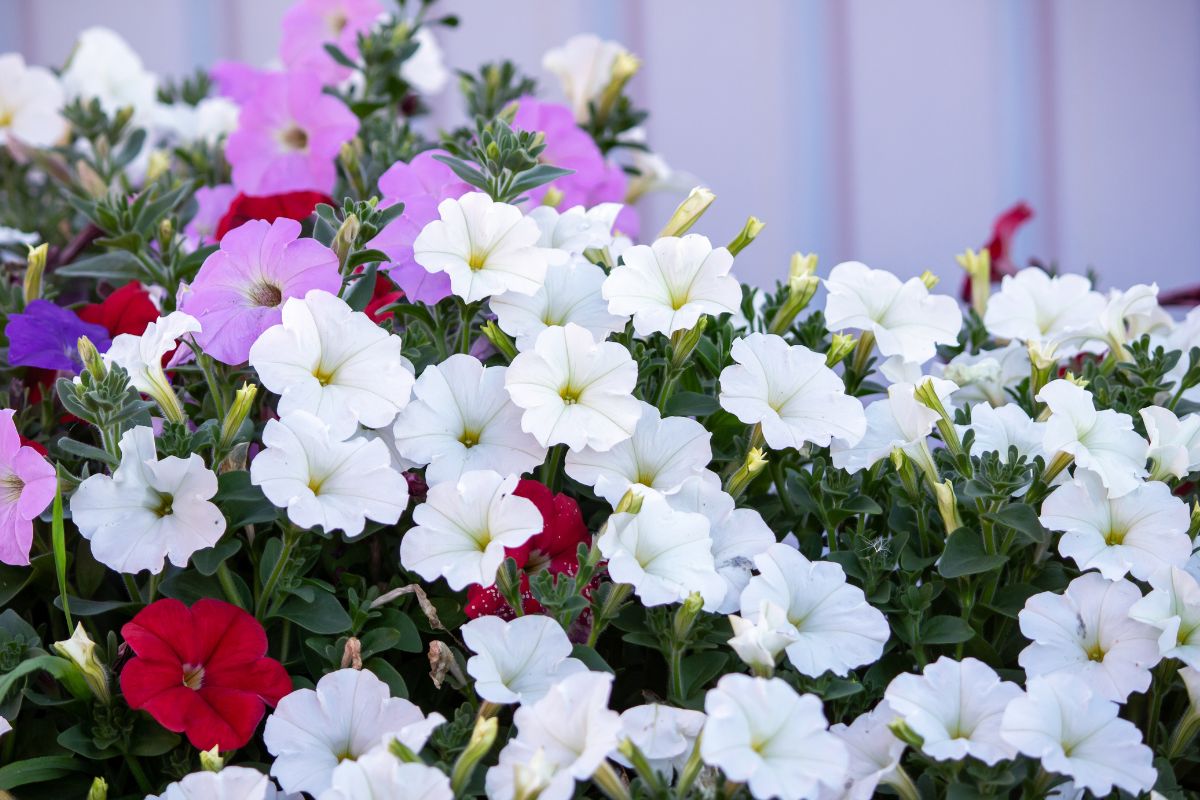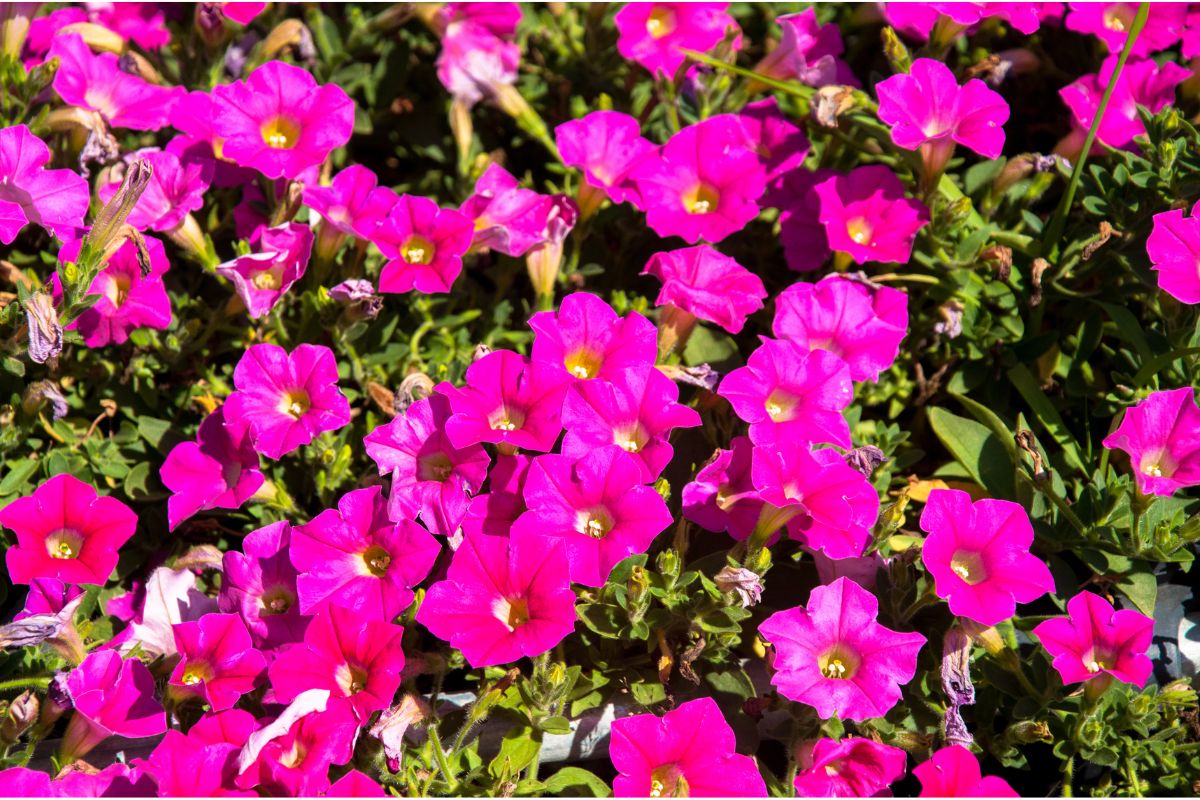The Vibrant Petunia Flower
For centuries Petunia has been a prevalent summer bedding plant; however, irrespective of when you plant it, you need to understand, is petunia annual or perennial?
Petunias are a symbol of mystery, fantasy, and charm. These compact and vibrant plants are excellent for growing in gardens and borders. They blossom from early summer to the beginning of fall.

Are Petunias Annuals or Perennials?
While most people consider Petunias as tender and vibrant perennials, the truth is that these plants won’t endure cold weather; thus, they are widely grown as annuals in many regions.
If you wish to retain your petunias as perennials for several years, do not leave them planted on the ground. Keep them indoors during the winter. However, if you live in a region that doesn’t get too cold, there’s nothing to worry about.
Other petunia species, like the trailing petunias, are often considered perennials. They can withstand and even flourish over the winter months. Read our article and find out what temperature is too cold for plants.
What Does a Petunia Look Like?
When planning to decorate your outdoor living space, nothing makes a spectacular addition more than petunia flowers. Their vibrant colors make them perfect for bringing life to your outdoor area. Surprisingly, not all people can identify them.
So, what are Petunias? Petunias are a native South American flowering plant. They come from the nightshade family and produce trumpet-like or bell-shaped flowers with somewhat sticky and hairy stems. Their flowers come in various colors, including red, white, red, black, and in some cases, stripes.
Depending on the species, you can find petunias in various types, colors, and heights—for example, single-colored, single, or double-flowering petunias, splashing or linear-colored petunias, etc.
Generally, they have five main groups based on their flower size. Here are five types of petunias available:
Grandiflora
Grandiflora petunias thrive well in hanging pots or baskets. Enormous flowers and vulnerability to rain and frost damage characterize them. This species does not fare well in the south since they are susceptible to rot during hot summers and humid climates.
Milifloras
Milifloras is the smallest compared to other Petunia variants. Despite being barely 1 to 1.5 inches (2.5 to 3.8 centimeters) wide, they produce abundant flowers that bloom the entire season.
Multiflora
These are the most resilient and productive petunia species. They are perfect for a mixed border and summer bedding since they produce numerous tiny flowers. Multiflora can withstand frost and wet weather.
Trailing Petunias
Trailing petunias, also known as spreading petunias, can extend their leaves and flowers as far as 3 to 4 feet (91.4 to 122 centimeters). Their flowers flourish throughout the whole length of each stem, forming a magnificent and vibrant ground cover. This species is ideal for window boxes and hanging pots or baskets.
Floribundas
Floribundas form a middle ground between Multiflora and Grandiflora. Similar to Multiflora, Floribundas are free-flowering species with medium-sized flowers.
Do Petunias Come Back Annually?
One question that has steered debate among Petunia growers is; do petunias come back? In many cases, yes! Petunias can come back annually. You plant them in fall or spring, and they will complete their life cycle each year for decades.
Sometimes the petunia plants reseed themselves. New plants will grow but might differ somewhat from the original petunia plant depending on pollination.
Basic Info on Growing Petunias
Growing Petunias is not a difficult task. Although some gardeners enjoy them as annuals, a few lucky ones who reside in suitable climates host them as perennials. But are petunias sun or shade plants? Petunias love to grow in full sun, even though they endure light shade during sunny summer.
While most people prefer to purchase petunia seedlings from a nursery, sometimes it’s worth taking up the challenge of growing petunias from seed. Start your petunia seeds 10 to 12 weeks before the last winter days. Spread the seeds on a moist seed bed and carefully press them down. Don’t bury them completely since they need light for germination.
Petunias are fast-growing flower plants. They thrive well in fertile and moist but not soaked soil. Dig in more compost, soil improver, or manure to help retain moisture in the soil.
Fertilize your Petunia flowers monthly with a balanced fertilizer to boost their hasty growth and flowering. For example, 12-12-12, 10-10-10, or 8-8-8 into the soil at 2 pounds (0.9 Kilograms) per 100 square feet (9.3 square meters).
The suitable temperatures for growing petunias are between 60° to 75° Fahrenheits ( 15.5° to 23.8° Celsius) during the day and 55° to 65° Fahrenheits ( 12.7° to 18.3° Celsius) at night. Although they can withstand temperatures as low as 40° Fahrenheits (4.4° Celsius), freezing temperatures and frost will ultimately kill your plants.
When your Petunias grow, prune their stems to enhance the growth of more branches and fuller plants. How far back you should prune depends on your plant. Cut about an inch or less if your plant is short or a stocky seedling. If it is gangly with longer stems, cut it back by half.

Caring for Petunias
If you grow your petunia indoors, place the pot in front of the sunniest window of your house. Petunias require plenty of sunlight until they hibernate. If they get insufficient sunlight, they can easily wither away. If you do not have a window letting in direct sunlight, keep your petunia flower outside from sunrise to sunset each day.
Wait until spring to fertilize or trim your petunia flower. Reduce the amount of water you give it each week. Once the petunia leaves have fallen off, stop watering entirely and keep your hibernating plant in a cool and dark location.
Keep in mind Petunias don’t require a lot of water and can withstand high temperatures except for the “spreading” type, which needs regular irrigation. In this case, leave your water sprinklers on to soak the soil about 6 to 8 inches (15.2 to 20.3 centimeters) deep every time you water.
Common pets and plant diseases might sometimes infest your Petunia plants; such pests include beetles, aphids, slugs, fleas, and tiny snails that eat petunia leaves and stems. You can splash them off using a strong water blast when watering your plant. However, use an insecticide if it’s a severe infestation and impeding flowering.
Ideas on Where and How to Use Petunias
Petunias are widely known for adding color to a garden. The colorful petunia flowers create a captivating sight. They are remarkably versatile, and you can use them in various ways. Here are some simple ideas on how to use Petunias:
- Use Petunias in containers as a spiller or filler component.
- Grow Petunias to add color to your seasonal landscape garden.
- Use Petunia flowers to prevent weeds in your garden and cover bare spots.
- Plant Petunia flowers separately in window boxes and hanging pots with other plants.
- Grow numerous Petunia flowers in a vast area for a stunning blanket of color.
- Decorate your window boxes with Petunias. Trailing petunias are ideal for window boxes; place them where they get 4 to 6 hours of sunlight.
- Create a magnificent flower border with Petunias. These plants make a sparkling patio, bedding, and border with stunning bright flowers.
- Add color to your veranda and balcony rails. Petunia plants in railing planters look adorable.
- Create a petunia tower. Use the trailing Petunias and let them spread on house pillars or poles, creating a beautiful petunia tower.
The Difference Between Annual and Perennial Flowers
Petunia plants have three major categories based on their lifespan: perennial, annual, and biennial. When a plant produces flowers and fruits, it has reached the end of its lifecycle. Here is how they differ from one another:
Annual Flowers
Annual flowers complete their life cycle in a single year. They germinate, grow, produce flowers and wither in the same year. Annuals are perfect for giving your garden a stunning flower show.
They germinate in the spring, blossom in the summer, release seeds, and die in the fall, completing their full life cycle in one year (Spring to fall). Annual flowers are spectacular in your garden and make a lovely cut flower bouquet you can show off at the dinner table or give to friends.
The notion that annual flowers are “one and done” and that they won’t grow again after their season is a widespread one. Most yearly flowers produce numerous seeds before they wither. Therefore, even if your original flower plant dies, a new seedling will sprout the following season.
Perennial Flowers
Perennial flowers, on the other hand, stay alive for more than two years. They continue to produce flowers and fruits for multiple seasons after growth. They get stronger year after year.
Unlike annuals that die when winter begins, perennials reserve their energy and hibernate during the winter, then become active again in the spring.
Perennial flowers concentrate their growth on their roots to establish a root network that can withstand hard and freezing soil.
This guarantees longevity and prevents most perennial flowers from wasting their limited energy on flowering the first year. Flowers won’t start to flourish until the second or third year.
For this reason, it’s crucial to plant annuals and perennials together in a new garden. The blooming of flowers shouldn’t take two years to happen!
Biennial Flowers
Biennial plants go through their entire life cycle in two years, as the name implies. They germinate, grow stems and leaves in the first year, produce flowers in the second year, and later die.
Biennial flowers can be cunning; some might not make it through the first winter, others might bolt (complete their lifespan in one growing season), and some might live for more than two years.
However, you can generally anticipate that flowers will wither in the next season’s fall, and new flowers will blossom the following spring.
You can plant biennials at the beginning of spring, so their roots have time to grow before exposure to the intense summer sun.

The Final Say
Petunias are one of the most prevalent annual flowering plants on earth; They are lively, bright and blossom from spring through winter. The fundamental requirement for growing petunia flowers is an area with sufficient sunlight. Most species will do well even if your soil has an undemanding need for watering or nutrient deficiency.
So, is a Petunia an annual or perennial? Well, that depends on the species you are growing. Regardless of how and which type of petunia you plant, use the caring tips and ideas of how to use petunias to create a colorful and breathtaking garden.
